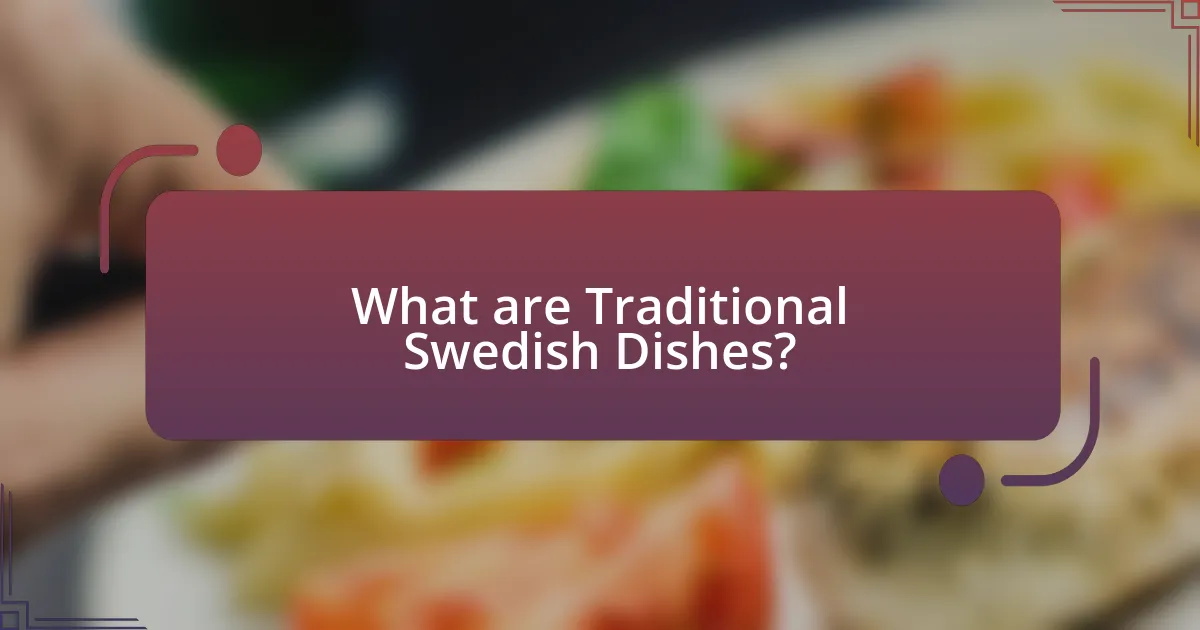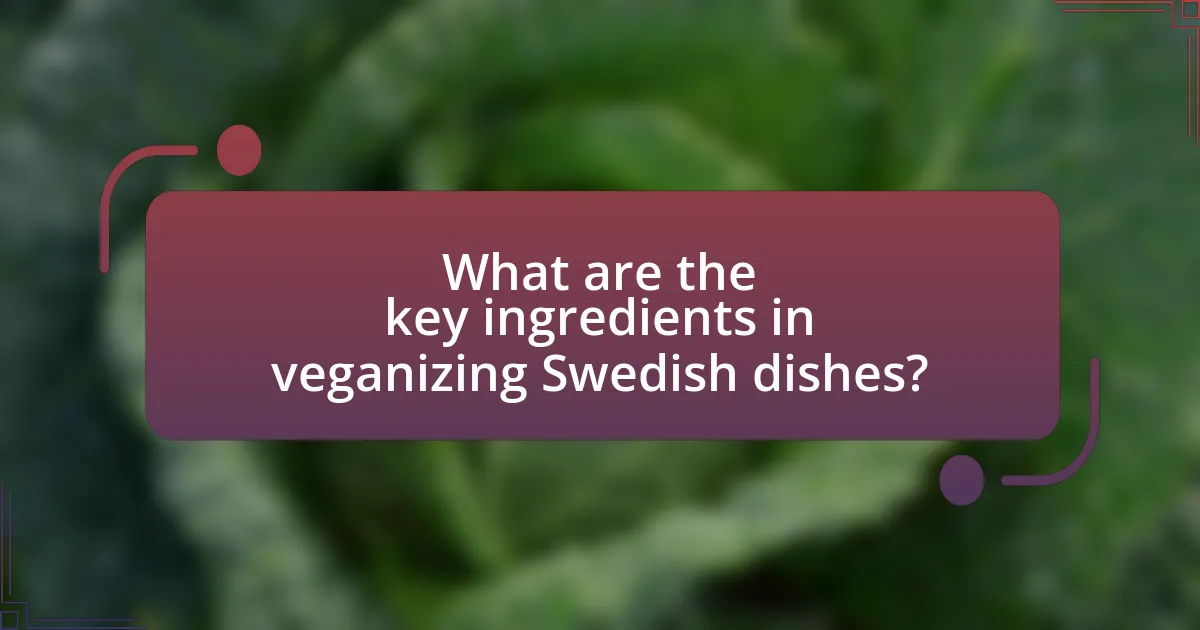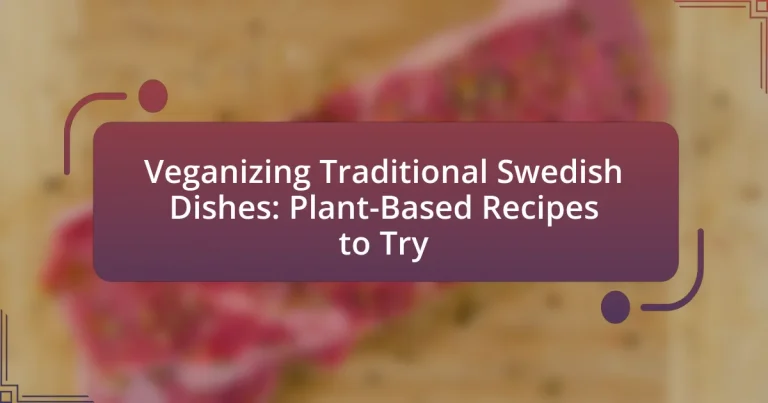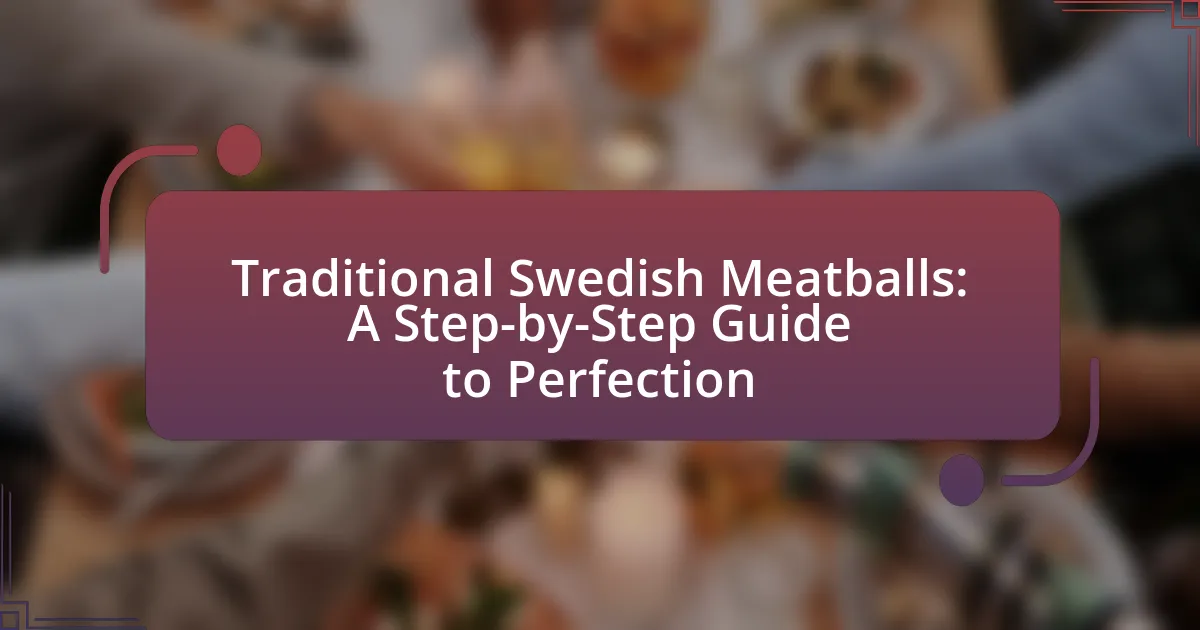The article focuses on veganizing traditional Swedish dishes, highlighting key recipes and ingredients that align with plant-based diets. It explores iconic Swedish foods such as meatballs, herring, and gravlax, detailing how these dishes can be adapted using plant-based alternatives while maintaining their cultural essence. The article also discusses the health benefits of vegan diets, the environmental impact of plant-based cooking, and provides practical tips for successfully transforming classic recipes. Additionally, it offers resources for finding vegan Swedish cookbooks and online communities that support plant-based cooking.

What are Traditional Swedish Dishes?
Traditional Swedish dishes include meatballs, herring, gravlax, and smörgåsbord. Swedish meatballs, known as köttbullar, are typically made from ground beef and pork, served with lingonberry sauce and creamy gravy. Herring, often pickled, is a staple in Swedish cuisine, commonly served during festive occasions. Gravlax, a cured salmon dish, is seasoned with sugar, salt, and dill, showcasing the importance of fish in Swedish culinary traditions. The smörgåsbord is a buffet-style meal featuring a variety of dishes, including cold cuts, cheeses, and breads, reflecting the diversity of Swedish food culture. These dishes are integral to Sweden’s culinary identity and are often enjoyed during holidays and celebrations.
How do traditional Swedish dishes reflect the culture and history of Sweden?
Traditional Swedish dishes reflect the culture and history of Sweden through their emphasis on local ingredients, seasonal availability, and historical influences from various periods, including the Viking Age and agricultural practices. For instance, dishes like herring and gravlax showcase Sweden’s maritime heritage, while meatballs and lingonberry sauce highlight the importance of foraging and preserving food in a harsh climate. Additionally, the tradition of fika, or coffee breaks accompanied by pastries, illustrates the social aspect of Swedish culture, emphasizing community and hospitality. These culinary practices not only provide sustenance but also serve as a narrative of Sweden’s agricultural evolution, trade routes, and social customs over centuries.
What are some iconic traditional Swedish dishes?
Iconic traditional Swedish dishes include meatballs, herring, and gravlax. Swedish meatballs, known as köttbullar, are typically made from a mixture of ground beef and pork, served with lingonberry sauce and creamy gravy. Herring, or sill, is often pickled and served as part of a smorgasbord, showcasing Sweden’s rich fishing heritage. Gravlax, a cured salmon dish, is seasoned with sugar, salt, and dill, reflecting traditional preservation methods. These dishes are integral to Swedish cuisine and cultural celebrations, such as Midsummer and Christmas, highlighting the country’s culinary history.
How have traditional Swedish dishes evolved over time?
Traditional Swedish dishes have evolved significantly over time, adapting to changes in ingredients, cultural influences, and dietary preferences. Historically, Swedish cuisine was heavily based on local and seasonal ingredients, with a focus on preservation methods such as pickling and smoking. In recent decades, there has been a shift towards incorporating more diverse flavors and international influences, as well as a growing interest in plant-based diets. This evolution is evident in the adaptation of classic dishes like meatballs and gravlax, which are now often made with plant-based alternatives to cater to vegan and vegetarian diets. The increasing availability of alternative ingredients has allowed traditional recipes to be reimagined while still honoring their cultural roots.
Why is there a growing interest in veganizing traditional dishes?
There is a growing interest in veganizing traditional dishes due to increasing awareness of health, environmental sustainability, and animal welfare. Research indicates that plant-based diets can reduce the risk of chronic diseases, with a study published in the Journal of the American College of Cardiology showing that vegetarian diets lower heart disease risk by 32%. Additionally, the environmental impact of animal agriculture is significant; the Food and Agriculture Organization reports that livestock production contributes to 14.5% of global greenhouse gas emissions. This awareness drives consumers to seek plant-based alternatives that align with their values, leading to a rise in veganized versions of traditional recipes.
What are the health benefits of a vegan diet?
A vegan diet offers numerous health benefits, including lower risks of heart disease, high blood pressure, type 2 diabetes, and certain cancers. Research indicates that individuals following a vegan diet tend to have lower cholesterol levels and healthier body weight, which contributes to overall cardiovascular health. A study published in the Journal of the American Heart Association found that plant-based diets are associated with a 25% reduction in the risk of heart disease. Additionally, vegan diets are rich in fruits, vegetables, whole grains, and legumes, providing essential nutrients and antioxidants that support immune function and reduce inflammation.
How does veganizing traditional dishes contribute to sustainability?
Veganizing traditional dishes contributes to sustainability by reducing the environmental impact associated with animal agriculture. The production of plant-based ingredients typically requires less land, water, and energy compared to raising livestock. For instance, a study published in the journal “Nature” found that shifting to a plant-based diet could reduce greenhouse gas emissions by up to 70%. Additionally, plant-based diets can lead to decreased deforestation and biodiversity loss, as less land is needed for crops compared to grazing livestock. Thus, transforming traditional dishes into vegan versions supports ecological balance and resource conservation.

What are the key ingredients in veganizing Swedish dishes?
The key ingredients in veganizing Swedish dishes include plant-based alternatives to dairy, meat, and eggs, such as tofu, tempeh, seitan, and various legumes. These substitutes allow for the replication of traditional textures and flavors found in Swedish cuisine. For instance, using cashew cream or coconut milk can replace dairy in sauces and desserts, while lentils or chickpeas can serve as protein sources in meat-based dishes like köttbullar (meatballs). Additionally, incorporating whole grains like barley or rye can enhance the nutritional profile and authenticity of the dishes.
What plant-based substitutes can be used for traditional Swedish ingredients?
Plant-based substitutes for traditional Swedish ingredients include using lentils or chickpeas in place of meat, cashew cream or coconut milk instead of dairy, and nutritional yeast as a cheese alternative. Lentils and chickpeas provide protein and texture similar to meat, making them suitable for dishes like köttbullar (meatballs). Cashew cream and coconut milk can replicate the creaminess of dairy in sauces and desserts, while nutritional yeast adds a cheesy flavor to dishes like gratins. These substitutes align with the growing trend of plant-based diets and have been shown to maintain flavor and nutritional value in traditional recipes.
How can dairy products be replaced in Swedish recipes?
Dairy products in Swedish recipes can be replaced with various plant-based alternatives. For instance, almond milk or oat milk can substitute for milk, while coconut cream or cashew cream can replace heavy cream. Additionally, nutritional yeast can provide a cheesy flavor in dishes, and silken tofu can serve as a substitute for sour cream or yogurt. These alternatives maintain the texture and flavor profiles typical of traditional Swedish dishes, making them suitable for vegan adaptations.
What are the best meat alternatives for traditional Swedish dishes?
The best meat alternatives for traditional Swedish dishes include lentils, mushrooms, and plant-based proteins like tofu and tempeh. Lentils serve as a hearty substitute in dishes like köttbullar (meatballs) and can be seasoned to mimic the flavor of meat. Mushrooms, particularly varieties like portobello or shiitake, provide a rich umami flavor and texture, making them ideal for dishes such as pyttipanna (hash). Tofu and tempeh can be marinated and grilled or sautéed, offering versatility in recipes like gravlax or meat-based casseroles. These alternatives not only maintain the essence of traditional Swedish cuisine but also contribute to a plant-based diet.
How can spices and flavors be adapted in vegan versions?
Spices and flavors can be adapted in vegan versions by utilizing plant-based alternatives that mimic the taste and aroma of traditional ingredients. For instance, smoked paprika can replace the flavor of smoked meats, while nutritional yeast can provide a cheesy, umami flavor in dishes. Additionally, herbs like dill and parsley, commonly used in Swedish cuisine, can enhance the freshness and complexity of vegan recipes. The use of spices such as cumin, coriander, and cardamom can also add depth and warmth to plant-based dishes, ensuring they remain flavorful and satisfying. These adaptations allow for the preservation of traditional flavors while adhering to a vegan diet.
What spices are essential in traditional Swedish cooking?
Essential spices in traditional Swedish cooking include dill, allspice, and white pepper. Dill is commonly used in dishes like gravlax and pickled herring, while allspice adds warmth to meat dishes and sauces. White pepper is often preferred over black pepper in Swedish cuisine for its milder flavor, particularly in creamy sauces and soups. These spices reflect the historical influences and regional ingredients of Sweden, contributing to the distinct flavors characteristic of its culinary traditions.
How can flavor profiles be maintained in vegan dishes?
Flavor profiles in vegan dishes can be maintained by using a variety of herbs, spices, and umami-rich ingredients. Incorporating ingredients such as nutritional yeast, miso, and fermented foods can enhance depth and complexity, similar to traditional flavor profiles. For instance, nutritional yeast provides a cheesy flavor, while miso adds a savory umami taste, which is crucial in replicating the richness often found in non-vegan dishes. Additionally, using smoked ingredients or roasting vegetables can introduce layers of flavor that mimic the depth of traditional cooking methods.

What are some popular veganized Swedish recipes to try?
Popular veganized Swedish recipes include vegan meatballs, vegan kanelbullar (cinnamon buns), and vegan gravlax. Vegan meatballs are made using lentils, chickpeas, or mushrooms combined with breadcrumbs and spices, replicating the traditional flavors while being plant-based. Vegan kanelbullar substitutes dairy with plant-based milk and butter, maintaining the sweet, spiced essence of the original. Vegan gravlax uses thinly sliced carrots marinated in a mixture of seaweed, liquid smoke, and spices to mimic the taste and texture of traditional salmon gravlax. These recipes reflect the essence of Swedish cuisine while adhering to vegan dietary preferences.
How can you make vegan versions of classic Swedish meatballs?
To make vegan versions of classic Swedish meatballs, use plant-based ingredients such as lentils, mushrooms, or chickpeas as the base. Combine these with breadcrumbs, onion, garlic, and spices like allspice and nutmeg to replicate the traditional flavor profile. For binding, incorporate flaxseed meal mixed with water or aquafaba, which acts similarly to eggs in conventional recipes.
Research indicates that lentils provide a good source of protein and fiber, making them a nutritious alternative to meat. Additionally, mushrooms add umami flavor, enhancing the overall taste of the dish. By baking or pan-frying the formed meatballs, you can achieve a desirable texture while keeping the dish healthy and vegan-friendly.
What ingredients are needed for vegan meatballs?
Vegan meatballs require ingredients such as lentils, breadcrumbs, onion, garlic, nutritional yeast, and spices like oregano and basil. Lentils serve as the primary protein source, while breadcrumbs provide structure. Onion and garlic add flavor, and nutritional yeast contributes a cheesy taste. Spices enhance the overall flavor profile, making the meatballs savory and satisfying.
What cooking methods work best for vegan meatballs?
Baking, frying, and simmering are the best cooking methods for vegan meatballs. Baking allows for a healthier option with less oil, while frying provides a crispy texture. Simmering in sauce enhances flavor and moisture. Research indicates that baking at 375°F for 20-25 minutes yields a firm texture, while frying in a skillet with a small amount of oil creates a desirable crust. Simmering in marinara sauce for 10-15 minutes can infuse the meatballs with additional flavor, making these methods effective for achieving the desired taste and texture in vegan meatballs.
What is a plant-based take on Swedish cinnamon buns?
A plant-based take on Swedish cinnamon buns involves substituting traditional ingredients with vegan alternatives. For instance, instead of using dairy milk and butter, one can use almond milk or coconut milk and vegan butter. Additionally, eggs can be replaced with flaxseed meal mixed with water or applesauce to maintain the dough’s texture. This adaptation retains the classic flavors of cinnamon and sugar while ensuring the recipe is suitable for a vegan diet. The use of these substitutes allows for a similar taste and texture to the original Swedish cinnamon buns, making them accessible to those following a plant-based lifestyle.
How can traditional dough be modified for a vegan recipe?
Traditional dough can be modified for a vegan recipe by replacing animal-based ingredients with plant-based alternatives. For instance, eggs can be substituted with flaxseed meal mixed with water or applesauce, which acts as a binding agent. Additionally, dairy milk can be replaced with almond milk, soy milk, or oat milk, providing the necessary liquid without animal products. Furthermore, butter can be substituted with coconut oil or vegan margarine, ensuring the dough retains its desired texture and flavor. These modifications maintain the integrity of the dough while adhering to vegan dietary requirements.
What are the best vegan fillings for cinnamon buns?
The best vegan fillings for cinnamon buns include a mixture of brown sugar, cinnamon, and vegan butter, which creates a classic flavor profile. Additionally, incorporating ingredients like chopped nuts, raisins, or dried fruits can enhance texture and taste. For a unique twist, consider using almond paste or a chocolate spread made from cocoa and plant-based ingredients. These fillings not only maintain the traditional essence of cinnamon buns but also cater to vegan dietary preferences.

What tips can help in successfully veganizing Swedish dishes?
To successfully veganize Swedish dishes, substitute traditional animal-based ingredients with plant-based alternatives. For example, replace dairy with almond or oat milk, and use flaxseed or chia seeds as egg replacements in baking. Additionally, utilize mushrooms or lentils to mimic the texture of meat in dishes like köttbullar (meatballs) or pyttipanna (hash). Incorporating spices and herbs can enhance flavor, ensuring the dish remains authentic. These substitutions maintain the essence of Swedish cuisine while adhering to a vegan diet.
How can you ensure flavor and texture are preserved in vegan dishes?
To ensure flavor and texture are preserved in vegan dishes, utilize umami-rich ingredients such as mushrooms, nutritional yeast, and miso. These components enhance the savory profile that is often sought in traditional dishes. Additionally, employing techniques like roasting vegetables to caramelize their natural sugars can improve both flavor and texture. For instance, studies show that roasting enhances the sweetness and depth of vegetables, making them more palatable in vegan recipes. Incorporating a variety of textures, such as crunchy nuts or creamy plant-based sauces, also contributes to a satisfying eating experience.
What common mistakes should be avoided when veganizing recipes?
Common mistakes to avoid when veganizing recipes include neglecting to replace key ingredients properly, which can lead to unbalanced flavors and textures. For instance, using water instead of plant-based milk can result in a dry dish, while omitting eggs without a suitable substitute may affect binding and moisture. Additionally, failing to adjust cooking times and temperatures can lead to undercooked or overcooked meals, as plant-based ingredients often require different handling than their animal-based counterparts. Lastly, not considering the seasoning adjustments needed for plant-based ingredients can result in bland dishes, as many vegan substitutes have milder flavors.
How can you experiment with ingredients to find the best substitutes?
To experiment with ingredients and find the best substitutes, start by identifying the key flavors and textures in the original dish. Then, systematically replace one ingredient at a time with a plant-based alternative, such as using lentils instead of meat or aquafaba instead of eggs. Document the results of each substitution, noting changes in taste, texture, and overall satisfaction. Research shows that certain combinations, like using nutritional yeast for a cheesy flavor or flaxseed for binding, can effectively mimic traditional ingredients in vegan recipes. This methodical approach allows for tailored adjustments based on personal preferences and dietary needs.
What resources are available for veganizing traditional recipes?
Numerous resources are available for veganizing traditional recipes, including cookbooks, online recipe databases, and food blogs dedicated to plant-based cooking. Cookbooks such as “Veganomicon” by Isa Chandra Moskowitz and Terry Hope Romero provide comprehensive guides on substituting animal products with plant-based alternatives. Online platforms like Minimalist Baker and Oh She Glows offer extensive collections of veganized recipes, often with tips on ingredient substitutions. Additionally, social media groups and forums focused on vegan cooking can provide community support and shared experiences in adapting traditional dishes. These resources collectively facilitate the process of transforming traditional recipes into vegan versions, ensuring accessibility and variety in plant-based cooking.
Where can you find vegan Swedish cookbooks or blogs?
You can find vegan Swedish cookbooks and blogs on platforms like Amazon, where titles such as “Vegan Sweden” by Anna Hult and “The Nordic Vegan” by Kalle Bergman are available. Additionally, popular food blogs like “Green Kitchen Stories” and “The Vegan Swedish Chef” offer a variety of plant-based Swedish recipes. These sources provide a comprehensive collection of vegan adaptations of traditional Swedish dishes, making them valuable resources for anyone interested in this cuisine.
What online communities can provide support and inspiration for vegan cooking?
Online communities that provide support and inspiration for vegan cooking include platforms such as Reddit’s r/Vegan, Facebook groups like Vegan Recipes and Vegan Cooking, and websites like Minimalist Baker and Oh She Glows. These communities offer a wealth of resources, including recipe sharing, cooking tips, and discussions about plant-based diets. For instance, r/Vegan has over 1.5 million members who actively share their experiences and recipes, making it a vibrant space for inspiration. Similarly, Facebook groups often feature daily recipe posts and cooking challenges, fostering engagement among members. Websites like Minimalist Baker provide a curated collection of easy vegan recipes, often with step-by-step instructions and photos, which can be particularly helpful for those new to vegan cooking.





